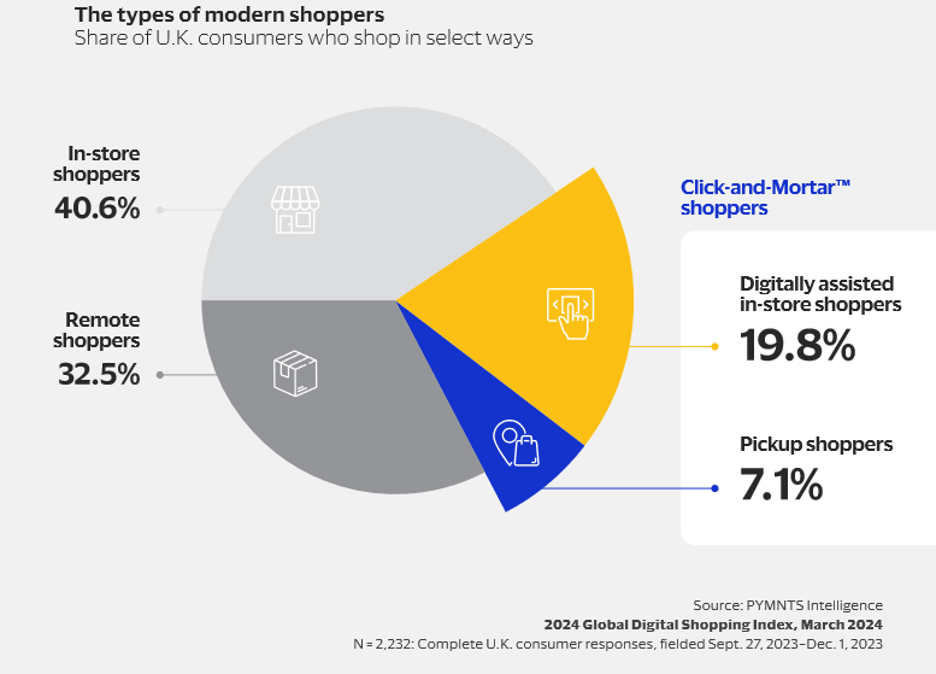UK Store Closures Put Spotlight on Digital Shoppers

One of the U.K.’s oldest retailers, Marks and Spencer (M&S) announced last week it plans to shutter 110 stores during the next five years.
This news comes only weeks after reports that the British division of The Body Shop was closing nearly half of its 198 U.K.-based stores and reducing its headcount by 40 percent.
Both retailers say the closures will enable them to put renewed focus on their digital strategies.
For M&S, the 140-year old retailer says it plans to update its shopping app, something the company believes will double its user base to 5 million by 2026, per a Startups report. The U.K. arm of Body Shop, meanwhile, says centering more on online sales will help it become “more nimble,” according to a Financial Times report.
A renewed commitment to digital features and online sales makes sense. PYMNTS Intelligence data shows U.K. merchants lag behind their counterparts in other regions when it comes to offering an optimized digital shopping experience.
In “The Global Digital Shopping Index: U.K. Edition,” PYMNTS Intelligence found that “by focusing on the strategic integration of digital tools both online and in-store and raising awareness about these features among consumers, U.K. merchants can capitalize on the unique aspects of the U.K. market.”
The report, which was commissioned by Visa Acceptance Solutions, draws on survey findings from nearly 14,000 consumers and more than 3,500 merchants across seven countries. The U.K. edition also reflected findings from surveys with 2,232 U.K. consumers and 570 U.K. merchants.
It found merchants in Great Britain, in particular, come up short when connecting digitally with local shoppers.
“U.K. consumers rank alongside those in Mexico and Brazil, reporting the lowest engagement with digital shopping features, averaging only 11 regularly used features — the lowest in the range of 11 to 18 average features used across the seven countries we studied,” according to the report.
But expanding the menu of digital shopping features alone may not be enough to remain competitive. The report also found that, for a growing segment of consumers, in-store shopping is part of the buying strategy. And, by drastically reducing the number of storefronts, merchants may undercut an opportunity to connect with this segment.

Enter Click-and-Mortar™ shoppers, a portion of consumers who now hunt for deals both in the store and online, look for rewards and bargains and scour the aisles for sales when they show up to pick up their online purchases in-store.
PYMNTS Intelligence estimates that, by optimizing the digital experience it provides consumers, U.K. merchants could see a 59% bump in consumer satisfaction among Click-and-Mortar™ shoppers.
And it’s a shopping segment merchants can’t afford to take for granted. The percentage of U.K. shoppers now using the Click-and-Mortar™ methodology has grown 30% since 2020. Today, 27% of U.K. consumers embrace it, which is especially popular with high-income spenders and younger consumers.
U.K. merchants must understand the importance of the Click-and-Mortar™ experience. While U.K. consumers show a strong overall preference for online shopping, nearly 41% remain in-store shoppers. With that in mind, merchants should consider taking steps to ensure the digital experience and the in-store experience complement one another.
On the tech front, U.K. merchants should consider providing their customers with more digital features. Even the most tech-savvy U.K. consumers use only about 16 digital features — far behind the 21 to 26 features consumers in other developed markets use when Click-and-Mortar™ shopping.
It’s not simply enough to provide more features. “The Global Digital Shopping Index: U.K. Edition” recommends merchants should also seize the opportunity to improve shopping experiences by making sure the features they offer are both user-friendly and discoverable. U.K. merchants must mind the gap between the digital features that consumers desire and those that are available. According to survey respondents, 27% of the most sought-after features they wanted were not offered by merchants, while another 31% were too difficult to find.

